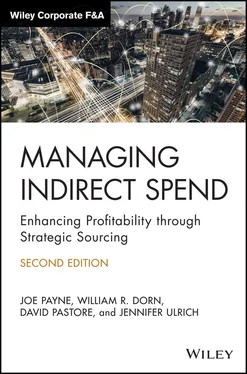Why do your competitors win business that you do not?
What measures do you take to ensure the quality of your product or service?
What is the process by which quality problems are resolved and corrected?
Do you provide any indemnification or insurance for your customers to protect against risk of loss due to product failure?
What are your standard payment terms? What are the terms for our organization?
Does our company take advantage of discounted terms?
How do you receive payment (check, ACH, etc.)? Do you have a preference?
What market changes and innovations are on the horizon for your industry? How does your organization intend to address those changes?
What are your goals and expectations for our account?
Of course, depending on the market and the supplier relationship, other questions should be considered, including questions related to price changes, freight terms (if applicable), and services, but these questions are a good start.
After going through the interview questions, review the reports that the supplier brought to the meeting. Do they include line‐item detail? If not, make the line‐item usage detail request an action item to be completed once the meeting is over. As we discussed earlier in the chapter, follow up the request by providing the supplier with a template indicating the type and detail of data you need and provide a deadline for completion of the request.
The last agenda item for a supplier interview is to inform the supplier of the process in which you are about to engage. You should be open and honest about the initiative, what's driving it, and your objectives. Let the supplier know that this is a company‐wide initiative and they are not being singled out. Keep in mind that, at this point, you do not know much about the competitiveness of the supplier's current pricing—you may already have a very good deal. Let the representative know that that just because your company is looking to reduce costs, this does not mean that there will be a bid. Also, make sure to communicate that you recognize they need to make money in order to stay in business, so your goal is to get to a market‐competitive price point that helps with your cost reduction objectives and helps them retain the business. Finally, ensure the supplier understands that all the critical aspects of the relationship and the supplier's service offering will be considered as you engage in this process.
ANALYZING CONTRACTS AND PRICING AGREEMENTS
By the time the end‐user and supplier interviews are complete, you will have collected all contracts or pricing agreements that are in place with your suppliers. At this stage in the process, your goal is not to rewrite agreements but to identify current contractual commitments and requirements. You need to analyze several key components to contracts and pricing agreements, including general terms, conditions and pricing information, service‐level information, and liability. This section of the book reviews the types of contractual commitments. Chapter 7covers what types of commitments you need to consider when entering into a new agreement.
General terms include items like contract start and expiration dates, renewal clauses, and termination clauses. It is important to understand contract start and end dates and termination clauses for several reasons. First, if a contract was executed recently and does not have a termination clause beyond default (essentially allowing the customer or supplier to cancel the agreement if terms of the agreement are not met), then, depending on your obligations under the contract, you may not be able to change suppliers until the contract end date.
Renewal clauses (also known as auto‐renew or evergreen clauses) are also important, because they may require that a termination notice be given a certain amount of time prior to contract expiration. For instance, a contract may expire in February of next year. However, the renewal clause states that the contract automatically renews for a one‐year term unless written notice is provided no less than 60 days before agreement expiration. This means you need to give notice that you do not intend on renewing the contract by November of this year.
Of course, pricing information is another important aspect of a contract or pricing agreement. While unit pricing is the most obvious pricing factor, contracts often include many other types of pricing:
Mechanisms for changing price. These could include an index‐based formulation linked directly to supplier raw material costs or a stipulation that prices will not exceed a certain percentage over a certain period of time.
Notification for price changes and guidelines for accepting or rejecting changes
Miscellaneous charges, such as freight or other servicing fees
Payment terms, including early payment discount and late payment fees
Discount or markup structures for goods and services not specifically unit‐priced in the agreement (such as noncore items for office supplies, or a tariff discount with AT&T or FedEx)
Taxes and surcharges, including how they are applied
Many other types of pricing information could be included in a contract or agreement, depending on the category. For example, a contract for print services might include tiered levels of pricing depending on the number of items printed in one order. We cover some of the other pricing information you can expect to see for specific categories in Chapter 7, “Get It in Writing: The Contracting Phase.”
As you can see, it is important to understand all aspects of pricing, beyond just the unit price. When the time comes to evaluate proposals from alternate suppliers, this information is critical for developing an apples‐to‐apples comparison.
Liability and Other Specific Terms
Most contracts also have clauses dealing with liability, insurance, indemnification, confidentiality, and other factors. Some of these terms are fairly generic. Others include information critical to the definition of the relationship between your organization and your supplier. Unfortunately, many end users hand this information over to their lawyers without fully understanding the business terms inherent within them.
A full evaluation of the types of clauses that could (or should) exist in a commercial agreement for products or services is beyond the scope and intent of this book. Many books and online resources are available that can help provide additional insight into contract law and the legal obligations of commercial relationships. However, it is important to note that when reading through these clauses you should understand not just what they are saying, but why they exist in the agreement. Is there mutual liability and confidentiality? Should there be? Is the supplier insured, and is this insurance adequate if the product fails? All terms need to be understood before they are executed in an agreement.
Service Level Requirements, Specifications, and Scope of Work
Some service‐level requirements and specifications will be detailed in the contract or pricing agreement and others may not. Regardless of where the information resides (within the terms of agreement or outside), this is the last piece of information to gather as part of the data collection process.
Service Levels and Scope of Work
Customers and suppliers often negotiate minimum service levels into agreements, particularly when agreements pertain to services (as opposed to products).
Many defined service levels are generic and are included in an agreement regardless of the product or service being provided. Examples include an agreement to provide sales or usage reporting on a regular basis, quarterly account reviews, or a dedicated sales representative.
Читать дальше












